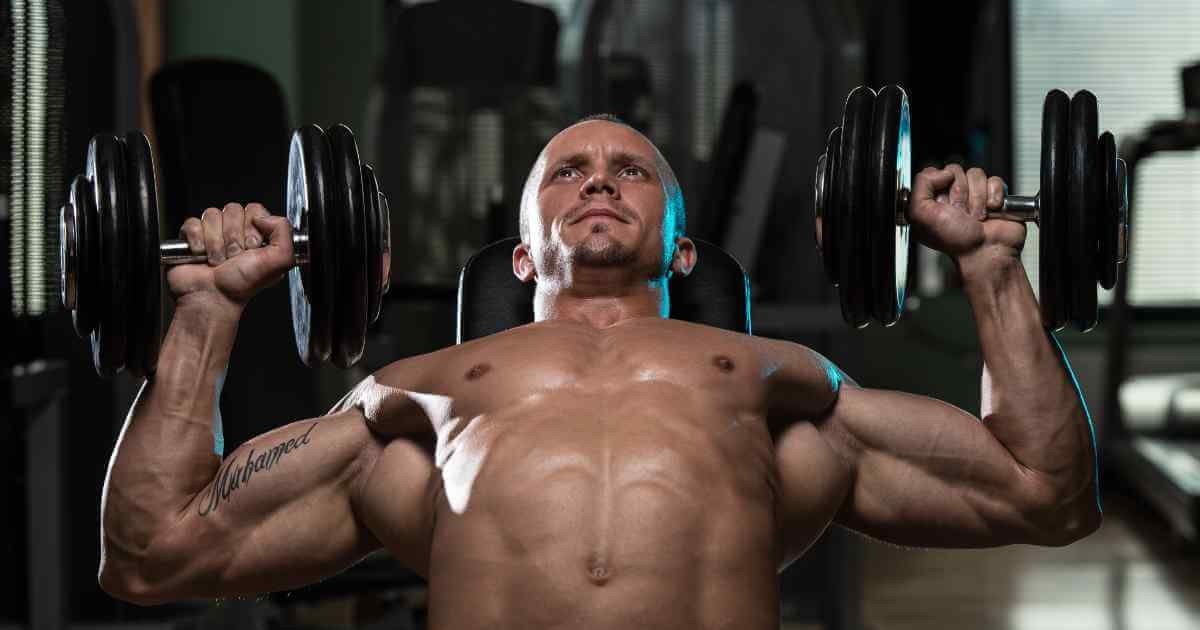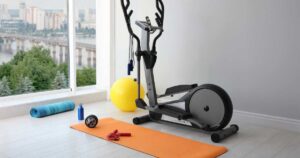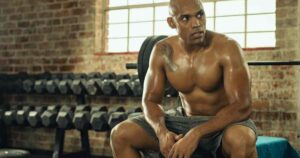Is dumbbell bench press a compound exercise for shoulder? This is a debatable question that has been controversial among fitness enthusiasts and professionals alike. To understand the answer, let’s first understand how this widely used exercise works.
Brief overview of the dumbbell bench press
A Dumbbell bench press is one of the most classic strength training exercises that target the chest, shoulders, and triceps muscles simultaneously.
The exercise uses two dumbbells held in each hand, lying flat on the bench and straightening the weights to the ceiling with slightly bent elbows. This movement imitates pushing movements that are common in activities and sports.
An important reason for this exercise’s popularity is the dumbbell bench press. One of these elements is the dumbbell bench press which made this practice so popular.
It is adjustable based on the diversity of fitness levels achieved from changing weights of dumbbells. Initiates can begin with lighter weights to concentrate on the right form and increase the resistance with their growing strength.
However, advanced lifters can stretch him or herself by increasing the amount of weight or introducing variations, such as incline or decline angles, or by using a combination of both.
This exercise also contributes to increasing upper-body strength while it helps engage core muscles for better stability and balance.
The muscles being worked during the dumbbell bench press are not limited to your pectoralis major (chest), but also your anterior deltoids (front shoulder), triceps brachii (back of upper arm), and even some recruitment from other stabilizing muscles such as your serratus anterior.
Hence, regardless of whether you are looking to improve the aesthetic appeal or improve the functional performance, incorporating the dumbbell bench press in your workouts can produce great results for newbie and veteran trainers alike.
However, before we explore all the possibilities it offers, it is important to understand what constitutes a compound movement when looking at exercises focusing on specific muscle groups especially those relating to shoulder development.
Importance of understanding if it’s a compound exercise for shoulders
In this regard, deciding whether the dumbbell bench press is a compound exercise for the shoulder is essential in your fitness journey.
Compound exercise is a physical activity that involves movements that target more than one muscle group and therefore, the strength and muscle development of the body are increased.
Knowing if the dumbbell bench press falls into this category can help you optimize your workouts and achieve your shoulder goals more effectively.
Compound exercises are very important in building strong shoulders. These exercises not only aim at major muscles but also activate the stabilizer muscles around them, which leads to the development of more efficient functional strength and uprightness.
The biomechanics of the dumbbell bench press are pulling the weights away from your chest while lying supine on a bench. Although its primary focus is on the chest muscles (pectoralis major), the exercise also utilizes secondary muscles such as triceps brachii, anterior deltoids (front shoulder), and even core muscles for stability during movement.
Is Dumbbell Bench Press a Compound Exercise for Shoulders?
The Dumbbell bench press is regarded as a compound exercise for the shoulder muscle by many experts as it involves many muscles of the shoulder complex.
The deltoid muscles are very essential in this exercise, especially the anterior deltoids which are located in the front part of each shoulder. As you raise the dumbbells, these front delts are engaged together with other assisting shoulder muscles.
The chest is the primary target of dumbbell bench press but other muscle groups are also involved in the exercise. The correct execution of this exercise tends to activate not only the pectoralis major and minor muscles but also a whole stabilizing muscle group like the triceps and deltoids.
During the movement, your deltoids are necessary to support the process of extension and stabilization of the shoulder. They work with your pecs to stabilize and create the power required to do the pressing move. This multi-muscle involvement makes it a compound movement.
Although some may claim that the target of this exercise is the development of chest strength, it is obvious that the engagement of the shoulders plays a significant role in proper dumbbell bench press performance.
Thus, adding this compound exercise to your workout program can help both those beginners who want to strengthen their overall upper body and advanced fitness enthusiasts striving for better shoulder stability and power.
SEE ALSO: HOW LONG DOES IT TAKE TO WALK 6 MILES?
Exploration of shoulder involvement during the dumbbell bench press
The key to maximizing the benefits of a dumbbell bench press is in understanding how your shoulders are involved in the process. Although this exercise works mostly on the chest muscles, the shoulders are essential in stabilizing and supporting the movement.
In this moment of the proper dumbbell press, your shoulders muscles do react, as you slowly lower and raise the weights. They assist with other muscle groups to help maintain stability and control all through each repetition.
When you lower the dumbbells towards the chest, your anterior deltoids contract to help you control the motion. This activation helps in the stabilization of your shoulders and also gives additional support to your pectoral muscles.
During the contraction muscle sequence of the exercise, primarily on the pull-up, both anterior and lateral deltoids engage. As they contract, these muscles provide a lot of force to help pull up and push away from gravity.
It is critical to observe that although there is clear involvement of the shoulder muscles during the dumbbell bench press, it may not be sufficient for full shoulder development. It would be worth your while to include specific shoulder exercises in your workout if you are trying to achieve hypertrophy or strength gains in your shoulders.
Expert’s opinions on its classification as a compound exercise
However, the dumbbell bench press is a compound shoulder exercise but the opinions of experts are different.
Moreover, some fitness experts maintain that if the main objective of this exercise is the improvement of the chest, then we cannot consider it a genuine compound move for the shoulder.
On the other hand, it is argued that, because more than one muscle is used, including the deltoids, it does count as a compound exercise.
As Eric Cressey who is the strength and conditioning specialist, says, the primary muscles working during dumbbell bench press are pectoralis major muscles in the chest, but other muscles such as anterior deltoids (front shoulders) are also involved in stabilizing and controlling the movement.
This participation of different muscle groups indicates the fact that compound movement does take place in this exercise.
Fitness trainer Bret Contreras commented that, although the dumbbell bench press involves some shoulder participation, its impact on developing shoulder muscles is not as significant as exercises specifically targeting the shoulders.
The statement that a Dumbbell bench press is a compound shoulder exercise is objective and only relies on what one thinks and what one wants to attain. The best idea is to get advice from trainers who are knowledgeable enough to be able to tailor their training according to the needs and goals of the individual.
Ways to Optimize Dumbbell Bench Press for Shoulder Engagement
The various strategies and modifications that you can use to maximize the use of shoulder muscles during the dumbbell bench press are as follows. With some modifications, you can pinpoint your shoulder muscles and exploit their benefits to the fullest.
Having proper form is very important for shoulder engagement in the dumbbell bench press. Be sure to pull in your scapula, and keep your core stable while performing the movement. This will aid in the engagement of muscles in your shoulders more efficiently.
Aside from good form, utilizing specific variations in your workout plan can also bring additional shoulder engagement. An efficient change is the incline dumbbell bench press. You place more of an emphasis on your anterior deltoids since you can make the angle of the bench more challenging.
Using resistance bands or chains during the exercise is yet another means of optimizing shoulder engagement. These tools introduce another level of tension at various points throughout the range of motions, requiring more work of the shoulders as they are stabilizing and controlling the weights.
Is It Possible to Injure Your Shoulders with Dumbbell Bench Press?
The same applies to the dumbbell bench press. While it can be an effective compound exercise for building strength in various muscle groups, including the shoulders, it’s crucial to prioritize safety.
One common mistake that can lead to shoulder injuries during the dumbbell bench press is improper shoulder positioning.
Allowing your shoulders to roll forward or rounding your upper back puts strain on the rotator cuff muscles and increases the risk of impingement.
To avoid this, focus on retracting your scapulae (shoulder blades) and keeping them stable throughout the movement.
Another factor that can contribute to shoulder injuries is lifting weights that are too heavy for you.
Trying to lift beyond your capabilities compromises form and places excessive stress on your joints and connective tissues. Always start with lighter weights and gradually increase as you build strength.
Final words
Is dumbbell bench press a compound exercise for shoulder? Well, after exploring the mechanics, muscle engagement, and expert opinions surrounding the dumbbell bench press, it’s clear that this exercise indeed qualifies as a compound movement for the shoulders. While its primary focus may be on strengthening the chest muscles, it also engages the deltoids to a significant extent.
Including the dumbbell bench press in your workout routine can bring numerous benefits, whether you’re a beginner looking to build overall strength or an advanced fitness enthusiast aiming to enhance shoulder development. Its versatility allows for customization based on individual goals and fitness levels.









